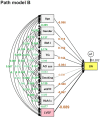Close linkage between serum uric acid and cardiac dysfunction in patients with ischemic heart disease according to covariance structure analysis
- PMID: 28559584
- PMCID: PMC5449391
- DOI: 10.1038/s41598-017-02707-y
Close linkage between serum uric acid and cardiac dysfunction in patients with ischemic heart disease according to covariance structure analysis
Abstract
High serum uric acid (UA) level has been assumed to be a risk factor for left ventricular (LV) dysfunction; however, the precise relationship between these conditions has not been fully examined because many confounding factors are associated with UA level. We herein examined the precise relationship by proposing structural equation models. The study population consisted of 1432 cases with ischemic heart disease who underwent cardiac catheterization. Multiple regression analyses and covariance structure analyses were performed to elucidate the cause-and-effect relationship between UA level and LV ejection fraction (LVEF). A path model exploring the factors contributing to LVEF showed that high UA was a significant cause of reduced LVEF (P = 0.004), independent of other significant factors. The degree of atherosclerosis, as estimated by the number of diseased coronary vessels, was significantly affected by high UA (P = 0.005); and the number of diseased coronary vessels subsequently led to reduced LVEF (P < 0.001). Another path model exploring the factors contributing to UA level showed that LVEF was a significant cause of high UA (P = 0.001), while other risk factors were also independent contributing factors. This study clearly demonstrated that there was a close link between high UA and LV dysfunction, which was represented by possible cause-and-effect relationship.
Conflict of interest statement
The authors declare that they have no competing interests.
Figures


References
MeSH terms
Substances
LinkOut - more resources
Full Text Sources
Other Literature Sources

